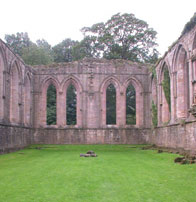 |
 |
 |
 |
 |
 |
 |
|
Fountains Abbey: History
Fountains Abbey: Buildings
|
The procedure at mealtimes (2/3) Think of how many people worked to prepare you
food, and
As soon as the monks heard the bell ringing to announce dinner (prandium) they made their way to the basins that stood to either side of the refectory entrance, to the west of the warming house (the lavabo), to wash their hands. Lead pipes carried water to stone basins, which were lined with pewter and set in niches. There was a towel cupboard east of the warming-house door.(66) Once they had washed their hands, the monks proceeded to the refectory where the tables were arranged in a U-shape around the walls. Remains of the stone table legs survive at Fountains. The monks sat on stone benches facing inwards; at Meaux Abbey, backs were added to the seats in the late fourteenth century. The food was already set on the tables, for the kitchener and cellarer, two monastic officers [obedientiaries], were to place the dishes on the table before the bell announcing dinner was rung. Food was passed to the refectory from the kitchen through a dumb-waiter-style hatch in the west wall. The monks stood while a blessing was read in Latin and then took their seats, but nobody was to begin until the prior (or whoever was presiding), had uncovered his bread. The prior sat on a dais at the southern end of the refectory, and a crucifix hung on the wall above his head; the pin-holes that supported this are still visible today.(67) The monks usually drank ale and ate vegetables and bread, but on special occasions, such as feast days, they might receive eggs, fish or a similar treat. Two types of bread were baked at Fountains, and Saturday was probably the main day for baking; grey loaves were fed to the dogs.(68) Meat was not to be eaten in the refectory but was later permitted in a separate building, the misericord.
The monastic community required a considerable amount of fish to feed the monks, lay-brothers and guests, and whilst the monastery fished in rivers and created its own freshwater ponds, Fountains also purchased fish. For example, stockfish (or ‘Icelandic fish’), that had been imported from Iceland or Norway was bought at Hull, York and Scarborough. The mid-fifteenth-century ‘Memorandum Book’ records various purchases of stockfish and the expense of its transportation to the abbey.(69) On one occasion it cost two pennies to transport five hundred of these salted fish to the abbey.(70) |
